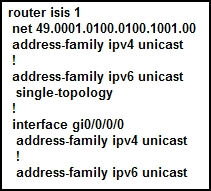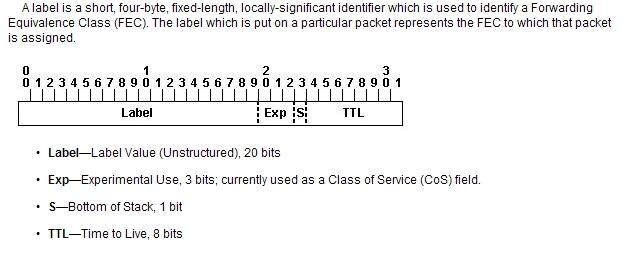Cisco® 642-883 Exam Practice Questions (P. 4)
- Full Access (191 questions)
- Six months of Premium Access
- Access to one million comments
- Seamless ChatGPT Integration
- Ability to download PDF files
- Anki Flashcard files for revision
- No Captcha & No AdSense
- Advanced Exam Configuration
Question #16
Refer to the IS-IS configuration exhibit.

This is the typical IS-IS configuration of the routers in an AS using IS-IS as the IGP. This AS is in the transition phase of integrating IPv6 into the network. During this transition phase, some of the routers within the AS might be running IPv4 only, some might be running IPv6 only, and others might be running both IPv4 and
IPv6. To avoid any black holes for the IPv6 traffic, which configuration change can be made?

This is the typical IS-IS configuration of the routers in an AS using IS-IS as the IGP. This AS is in the transition phase of integrating IPv6 into the network. During this transition phase, some of the routers within the AS might be running IPv4 only, some might be running IPv6 only, and others might be running both IPv4 and
IPv6. To avoid any black holes for the IPv6 traffic, which configuration change can be made?
- ADisable IS-IS adjacency checks.
- BEnable IPv6 adjacency over IPv4 IS-IS peering.
- CEnable multi-topology IS-IS.
- DDisable the IPv4 unicast address-family.
- EEnable IS-IS wide metric to support the single-topology mode.
Correct Answer:
C
C
send
light_mode
delete
Question #17
When implementing OSPF, which type of networks require DR/BDR election?
- Apoint-to-point networks
- Bmutli-access broadcast networks
- Cnon-broadcast multi-access networks (Hub and Spoke Frame Relay) using point-to-multipoint OSPF network type
- DAll networks type
Correct Answer:
B
B
send
light_mode
delete
Question #18
The S bit in the MPLS header is used for what purpose?
- ATo indicate the bottom level in the label stack
- BTo indicate if LDP is sync to the IGP
- CTo indicate if LDP is sync to the IGP
- DTo indicate the status of theLSP
Correct Answer:
A
 a 1-bit bottom of stack flag. If this is set, it signifies that the current label is the last in the stack.
a 1-bit bottom of stack flag. If this is set, it signifies that the current label is the last in the stack.
A
 a 1-bit bottom of stack flag. If this is set, it signifies that the current label is the last in the stack.
a 1-bit bottom of stack flag. If this is set, it signifies that the current label is the last in the stack.
send
light_mode
delete
Question #19
What are two purposes of the BGP scan-time command? (Choose two.)
- Ato tune the BGP process which walks the BGP table and confirms the reachability of next hops
- Bto allow faster detection of downed BGP peers
- Cto improve BGP convergence time
- Dto tune the BGP update interval
- Eto decrease the effects of unstable routes by increasing the route suppression time
Correct Answer:
AC
http://www.networkers-online.com/blog/2008/12/bgp-performance-tunning-convergence-stability-scalabilityand-nsf-part-2/
Background BGP scanner -
It is responsible for BGP housekeeping by scanning both the BGP RIBand the IP RIB and cleaning and sorting things out.
BGP monitors the next hop of the installed routes to verify next-hop reachability and to select, install, and validate the BGP best path. By default, the BGP scanner polls the RIB for this information every 60 seconds.
During the 60 second time period between scan cycles, IGP instabilities or other network failures can cause temporarily black holes and routing loops.
NOTE With Cisco IOS the default timer is 60 seconds for the IPv4 address family and 15 seconds for the
VPNv4 address family in order to optimize the VPNs routing table convergence.
This timer can be controlled via the following command:
Router(config-router)#bgp scan-time <5-60>
AC
http://www.networkers-online.com/blog/2008/12/bgp-performance-tunning-convergence-stability-scalabilityand-nsf-part-2/
Background BGP scanner -
It is responsible for BGP housekeeping by scanning both the BGP RIBand the IP RIB and cleaning and sorting things out.
BGP monitors the next hop of the installed routes to verify next-hop reachability and to select, install, and validate the BGP best path. By default, the BGP scanner polls the RIB for this information every 60 seconds.
During the 60 second time period between scan cycles, IGP instabilities or other network failures can cause temporarily black holes and routing loops.
NOTE With Cisco IOS the default timer is 60 seconds for the IPv4 address family and 15 seconds for the
VPNv4 address family in order to optimize the VPNs routing table convergence.
This timer can be controlled via the following command:
Router(config-router)#bgp scan-time <5-60>
send
light_mode
delete
Question #20
When using the show bgp ipv6 unicast summary command to verify the IPv6 BGP session status with the IPv6 BGP peers, you noticed the "St/PfxRcd" status for one of the IPv6 BGP peers is in the "Active" state. What does the "Active" state indicate?
- AThe IPv6 BGP session has been established with the IPv6 BGP peer.
- BThe router is in the process of sending BGP routing updates to the IPv6 BGP peer.
- CThe router is in the process of establishing the IPv6 BGP session with the IPv6 BGP peer.
- DThe router is exchanging BGP notification messages with its IPv6 BGP peer.
Correct Answer:
C
C
send
light_mode
delete
All Pages
